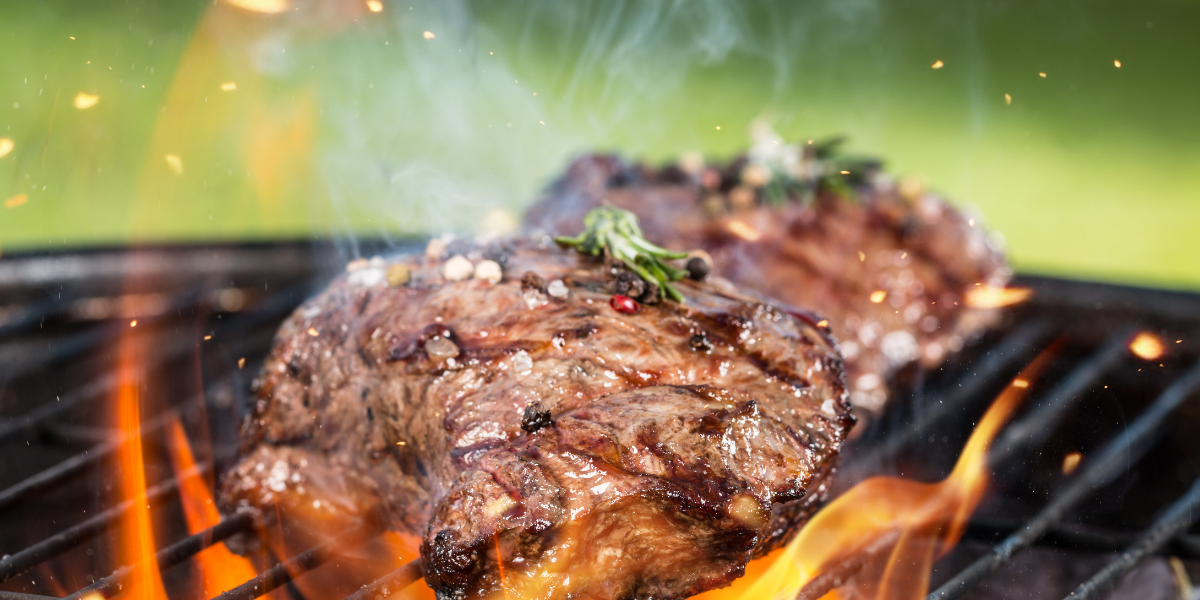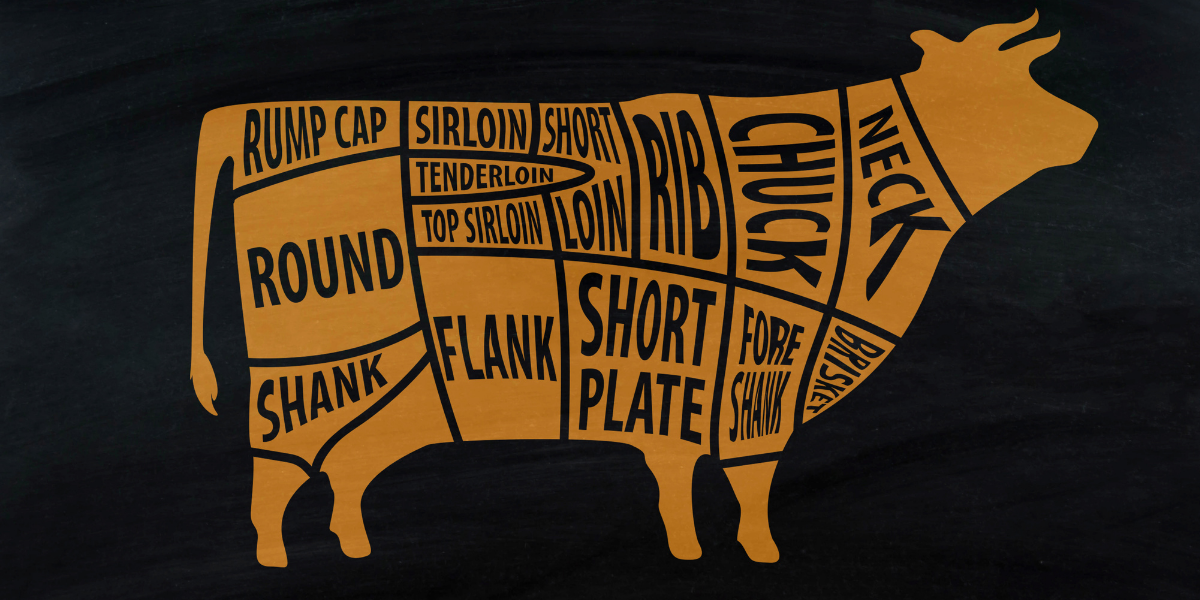Help Isom IGA recover from devasting floods

Summer is the perfect time for grilling with your family and friends. There's nothing quite so American as a summer barbecue in the backyard. But the perfect barbecue requires knowledge about how to cook the perfect cut of meat. The first step to ensuring that you cook your meat perfectly is to be informed about various cuts of meat. This handy guide will help you recognize different types of meat, how to select the best meats, and some quick tips on cooking them perfectly.
Fresh cut beef comes in a wide variety, and the cut is determined by the location of the cow that the cut came from. Butchers call these different areas primal cuts. Primal cuts are then further divided into sub-primal cuts, which are then cut into the steaks and cuts you are used to buying. Knowing which area a cut comes from helps you know exactly how to cook that cut of local beef.

Chuck
Chuck comes from the neck and shoulder part of the cow. The chuck, in general, tends to be tougher, but it is also quite flavorful if cooked properly. Chuck can be cut in many different ways, so there is a lot of variety in the types of chuck you can get. For example, you can get ground chuck, chuck pot roast, chuck steak, clod roasts, blade steak, country-style ribs, and stew meat, among others. Chuck comes out well when you braise it. You should cook it in a liquid for a long and slow period of time. Chuck is also a good option when you want a flavorful meat but are also on a tight budget, as these cuts tend to be more cost-friendly.
Brisket
The brisket comes from the cow's breast. Brisket also tends to be tough like chuck, and it can have a very high proportion of fat. However, brisket makes a very tasteful cut as well. Brisket should always be tenderized and braised, and like chuck, it should be cooked on low heat for a very long amount of time to bring out the flavor and keep it very tender. Corned beef and pastrami are both made from brisket. It's also good for a backyard barbecue cooked all afternoon.
Ribs
Ribs consist of both the breast and the backbone of the steer. Typically, there are 26 ribs that come in 13 separate pairs, but only the last half is used as ribs. The rest are included in the chuck cuts. Ribs tend to be very tender and full of flavor. They also have a high amount of marbled fat, but this adds to their tenderness and flavor. Ribs make a delicious steak, such as a ribeye, Delmonico, or cowboy roast. They also can be cut as beef short ribs or rib roast. Either way, you will get a very tender and juicy steak that comes out perfect on your grill.
Shank
The shank also comes from the cow's breast and is similar to the brisket. The difference is that the shank is on the forearm, which is in front of the brisket. The shank may be the toughest cut of beef that you will find on the cow. Thus, it is most suited for a soup or a stew where it will be braised and submerged in liquid to help it become more tender. Shank is used to make osso buco, a delicious dish made with wine.
Loin
The loin is typically where you will find your most expensive cuts. It is also the most tender part of the cow and produces some of the most-loved pieces of fresh-cut beef. It is located on top of the cow behind the ribs. Its location is what results in its tenderness. Since this muscle is not very commonly used, it tends to be the most tender in the entire animal. The loin is further broken down into two other areas: short loin and sirloin.
Short loin
Short loin produces many common cuts of beef that you have probably enjoyed at steak houses or home. For example, the T-bone, sirloin, New York strip, and Porterhouse all come from the short loin. These are all very tender cuts of beef that cook up perfectly on your grill. The filet mignon and tenderloin also come from the short loin and are among the most exceptionally tender and delicious cuts of beef.
One interesting but a little-known fact is that the T-bone and Porterhouse both come from the same cut of the short loin. The only actual difference between these two cuts is that the Porterhouse is a bit larger than the T-bone. Removing the meat from around the bone in a T-bone yields several other steaks. This is where you get both a filet and a strip steak. This could include such commonly known cuts as a New York Strip or Kansas City strip, both of which are exceptionally tender.
Sirloin
The other cut that comes from the loin is the sirloin. Sirloin is a bit less tender than short loin but still a very delicious and tender choice for local beef. One advantage that sirloin has over short loin is that it tends to be more flavorful. So, you sacrifice a bit of tenderness but get more flavor in return.
The sirloin produces many delicious cuts that you have probably seen on menus. For example, the top sirloin, tri-tip steak, bottom sirloin, tri-tip roast, and ball tip steak all come from the sirloin cut. Sirloin is an excellent choice of beef if you want a very tender and flavorful steak that will be incredibly juicy on your grill. It's easy to cook and can be marinaded or cooked fresh out of the package. Sirloin is almost always sure to be a hit.
Round
The round is a good cut to select if you are on a budget. The round is lean, making it less tender and tougher than most cuts. However, it can still make a tasty steak if prepared properly. The round comes from the cow's hind quarters, which is partly why it is so tough. It can make a fantastic pot roast, but you should always take caution that you don't overcook it, or you will make it too tough to eat.
Round is commonly used for ground beef. It can also be sold as the eye of round, a tip roast, or a top or bottom round steak. Regardless of how it is cut, you will want to be sure to tenderize it or marinate it well to avoid it being overly tough. With any cut from the round, you should be cautious that you do not overcook it.
Flank
The flank cut is found beneath the loin. As the flank has no bones, it is a cut with a very strong and delicious flavor. However, it can also be quite tough, so it needs to be prepared with this in mind. The flank used to be known as an inexpensive cut of beef to choose from, but recently the price of flank has started to rise. This is because flank is one of the leanest cuts of beef, and people have recently become more intent on reducing their fat intake. Thus, the price of flank steak has risen accordingly.
Flank cuts that you are likely to see at the supermarket include the flank steak or the London broil. The key to cooking this correctly is to marinate it first. After marinating, it does very well on the grill. You will want to be sure to cut it in thin slices that go against the grain for the best results. It would do great on a sandwich or hoagie or a salad.
Plate
The plate cut is also known as the short plate. This is the other section of ribs that weren't included in the ribs. It is closer to the cow's abdomen and thus is fattier. This makes for a very juicy and delicious cut. The plate can be cut into skirt steak, short ribs, Philadelphia steak, or pastrami. It also does well in fajitas and other Mexican dishes. If you are making a skirt steak, it turns out very well if you marinate it first. Then, put it on the grill and cook it to your desired tenderness. On the other hand, if you make short ribs, it is ideal to braise them first before cooking them.
Hopefully, you've learned about the large variety of beef to choose from when you are selecting your cut of meat. You should choose carefully depending on how you plan to cook it and how you want the result to turn out.
How to select beef
One other thing to consider when you are at the supermarket is whether you want grass-fed beef. If you select these cuts, you should be sure to cut your cooking time in half. Once you have reached that point, gradually add more time in increments of five minutes until it appears done to your liking.
You also need to ensure that the beef you purchase is still cold. It should not be warm or at room temperature to preserve its freshness. The ideal cut of beef should be either purplish-red or bright red. You don't want to see brown spots on the cut. You should always choose cuts of beef in transparent packaging so that you can assess their color in advance.
You should also check the marbling of the beef before you buy it. Marbling should be consistent throughout the cut rather than concentrated in one area. Lean cuts of beef such as the flank steak should not have much marbling, but other cuts such as the ribeye should have plenty of marbling. It's also good to check on the grade of beef. Prime beef is best, followed by choice, and then select.
By following these guidelines, you will certainly select the perfect cut of beef next time you plan to grill or prepare meat for your family and friends. Be sure to pay attention to what you're buying or communicate your needs clearly to your butcher. Most importantly, enjoy those delicious cuts of beef at your backyard barbecue this summer!
Next Story
Tips for Packing the Perfect Picnic →